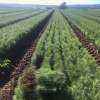
Tasmanian RFA outcomes report released
Posted 29 July 2024
The outcomes report for the fifth review of the Tasmanian Regional Forestry Agreement(RFA) has been released. The report marks the first stage in the independent review process, which will now progress to stakeholder consultation.

Interested individuals are encouraged to provide their feedback to the outcomes report through a have your say consultation managed by the Department of State Growth. Individuals have until midnight on 30 August 2024 to have their say via this link.
Established in 1997, the RFA is a joint initiative funded by the Commonwealth and Tasmanian Governments that sets out a long-term plan for the management and conservation of Tasmania’s native forests. The outcomes report covers the 2017 to 2022 period and marks the first review since the RFA was extended in 2017 for an additional 20-year period. The 5-yearly review process is critical to ensuring the Tasmanian RFA’s objectives are still being met.
As part of the RFA review, Professor Jerry Vanclay from Southern Cross University has been appointed as the independent reviewer. He will now undertake a detailed consultation process as he considers the outcomes report and develops his own independent report. Professor Vanclay is a pioneer in the modelling of forest ecosystems and has significantly influenced the sustainable management of forests worldwide.
The comprehensive review underscores the commitment to sustainably managing Tasmania's forest resources and highlights significant advancements and compliance in forestry practices.
Have your say HERE.
Share this Article
Latest Articles
-

17 September 2025
Celebrating excellence at the Tasmanian Timber Awards
-

17 September 2025
Forest Practices Authority Research Update Day
-

13 August 2025
Have you seen our Stems for CO2 Project signage on the Midlands Highway?
Archives
- ActivAcre hits milestone, calls for more farmers to get on board
- Napier's leading the way in sustainable forestry and carbon-neutral farming
- Sound science needed to assess carbon impacts of timber harvesting
- Newly appointed TFFPN Board of Directors
- Graduate Certificate of Forestry Scholarship
- Forestry Australia Mentoring Program 2025
- Forest Industry Roundtable planning for the long term
- Eagle Management Constraint Period extended
- Successful private native forest management celebrated
- $15 million investment in new ship loader to boost Bell Bay's forestry exports
- Standing with Tasmania's forestry industry: buy local
- TFPA: Tasmanian Freight Equalisation Scheme needs a ground-up review
- AFCA Gala Dinner celebrates industry excellence
- Fire permits now required Statewide
- Forest leaders hone skills in sustainable native regrowth management
- Tasmanian forests and the carbon market: Barriers and opportunities
- Spring is the time for fuel reduction burning
- Primed for Growth: A situation analysis of the Tasmanian Forest and Wood Products Sector
- Audit requirements cut for low-risk plantation projects
- Guidance and support for landowners after damaging winds
- Forestry Australia welcomes further definition of active forest management
- Farm & Forest Mapper Tool highlighted at Rural Youth Tasmania's Young Farmer of the Year competition
- Senate Select Committee inquiry into the Tasmanian Freight Equalisation Scheme
- Timberlink announces new wood composite products brand
- Newly developed protocol a vital tool for safeguarding forestry industry
- Red Hot Tips: Fire management for Tassie farmers
- Bioenergy: Fuelling industries with trees
- Harvesting trees: What you need to know
- Shelterbelts: How are they contributing to farm systems?
- Infill plantings and remnant vegetation: Why biodiversity depends on a thriving understory
- Plantation planning: The key to a successful plantation
- Exciting interactive forestry knowledge hub launched
- $450,000 farm forestry grant recipients revealed



